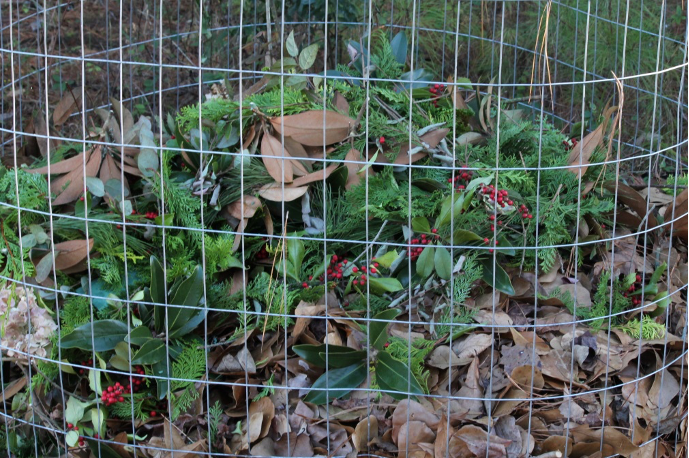Recycle Your Discarded Christmas Tree This Year!
go.ncsu.edu/readext?838836
en Español / em Português
El inglés es el idioma de control de esta página. En la medida en que haya algún conflicto entre la traducción al inglés y la traducción, el inglés prevalece.
Al hacer clic en el enlace de traducción se activa un servicio de traducción gratuito para convertir la página al español. Al igual que con cualquier traducción por Internet, la conversión no es sensible al contexto y puede que no traduzca el texto en su significado original. NC State Extension no garantiza la exactitud del texto traducido. Por favor, tenga en cuenta que algunas aplicaciones y/o servicios pueden no funcionar como se espera cuando se traducen.
Português
Inglês é o idioma de controle desta página. Na medida que haja algum conflito entre o texto original em Inglês e a tradução, o Inglês prevalece.
Ao clicar no link de tradução, um serviço gratuito de tradução será ativado para converter a página para o Português. Como em qualquer tradução pela internet, a conversão não é sensivel ao contexto e pode não ocorrer a tradução para o significado orginal. O serviço de Extensão da Carolina do Norte (NC State Extension) não garante a exatidão do texto traduzido. Por favor, observe que algumas funções ou serviços podem não funcionar como esperado após a tradução.
English
English is the controlling language of this page. To the extent there is any conflict between the English text and the translation, English controls.
Clicking on the translation link activates a free translation service to convert the page to Spanish. As with any Internet translation, the conversion is not context-sensitive and may not translate the text to its original meaning. NC State Extension does not guarantee the accuracy of the translated text. Please note that some applications and/or services may not function as expected when translated.
Collapse ▲Though there may no task more disheartening (or messier) than removing your Christmas tree, it does not necessarily mean that its last stop is the curb with the empty gift boxes. How about this year going for a greener approach and extending the life (and function) of that hold tree?
Trees as a wildlife habitat
One of the easiest and most effective ways to recycle Christmas trees is to make it a home for backyard wildlife. Winter can be a difficult time for overwintering songbirds as food and shelter become quite scarce. Consider placing your tree in the backyard or garden as the branches provide nesting habitat and refuge from winter winds. Another way to give wildlife a foot-up in the winter months is to hang fruit slices, or strings of cranberries or raisins from the branches which will serve as a food source for songbirds or small mammals.
If you choose this option, make sure that the tree is well away from any permanent structures such as homes and sheds. Pine resin is extremely flammable so care should be taken to avoid placing them near structures that could catch fire. If you have a pond, consider placing the entire tree in the water, as tree skeletons provide shelter and structure for which many fish depend on for nesting. If this is not an option for you, consider seeking out hunting or fishing clubs which may be interested in taking a used tree to use for wildlife.
Trees as compost
Another option for recycling old trees is to trim branches from the main trunk and place them over your winter perennials. This will serve as an added layer of insulation during nights when temperatures get below freezing. Limbs will breakdown and provide extra nutrients to plants. Evergreen layers of tree boughs also help slow the early flush of weeds in the spring. Trimmed branches can also be used in compost bins, but remember that smaller branches break down more quickly than large ones, so consider cutting each limb into 6-8” pieces or smaller.

Discarded greenery can easily be added to the compost pile. Photo credit: Sam Marshall
This applies also to other living greenery decorations from your home. Another option is to have trees mulched and to use the mulch around landscape trees or shrubs. If you cannot compost at home, consider donating your tree to be composted offsite. Many solid waste services will recycle old trees either free of charge or for a small fee if dropped off at convenience sites. Check with your local solid waste service agency and ask about convenience sites and the dates when trees will be collected.
Get creative!
There are some very creative ways to reuse that old tree. By cutting branches and sticking them in the ground in such a way that forms a picket fence, you can protect your landscape trees and shrubs from drying winter winds. Old Christmas trees can also be used as a trellis system for your summer garden plants like runner beans or peas. Planted densely enough, the vines will cover the entire skeleton of the tree and can serve as a useful, sustainable, (and attractive) display for your home garden.
One thing that you should NOT do however is to burn Christmas trees in fireplaces. Again, pine resin is highly flammable and a dry tree can practically explode into flames. Burning trees also deposits resin in the chimneys and over time, build of resin can present a fire hazard.
Just because you are done with your tree does not mean it does not still have its uses! Recycling old trees has many benefits to your home garden as well as to wildlife, so before tossing it to the curb, consider giving it a second chance this year by recycling it. For the environmentally- and economically-minded gardener, recycling a tree is just one more way you can save money and help ensure a greener 2022.
And, as Cousin Eddie observed, “…it’s the gift that keeps on giving the whole year long.”




